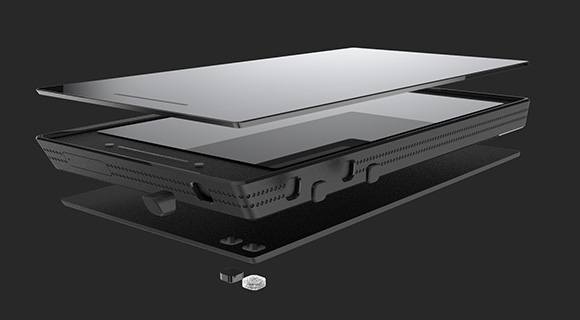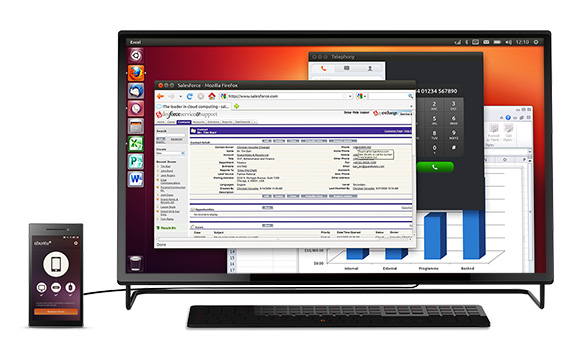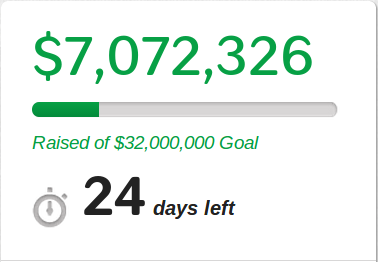The Ubuntu Edge: Can Canonical succeed?

I’m sure by now all readers know about Canonical’s rather ambitious goal of financing the creation of its own smartphone through crowdfunding. Mark Shuttleworth’s company isn’t playing around either, he doesn’t want just to build a smartphone, he wants to buildthe smartphone meant only for the biggest tech enthusiast out there, using technology that’s cost prohibitive on the consumer space.
In order to do manufacture their dreams they’ve estimated they need 32,000,000 dollars. That’s not a small number, in fact, is big enough to break all crowdfunding campaigns to date. Meeting their goal obviously requires a bunch of things to align, miss one of them and the entire project goes down. Can they pull it off? Do they meet every requirement?
Ubuntu Edge: The hardware story
The edge will only get financed if the hardware is attractive. Make the phone ugly, make it with lacking internal specs, and failure awaits. Does the Edge delivers in this regard?
The Edge’s exterior was clearly crafted with a ton of care, it’s not just a plastic soap bar with a screen in the middle. Canonical has instead gone with a unibody metal design that certainly catches the eye: It mixes an elegance and modernity without looking boring.
Ironically, it instantly reminded me of the Surface RT, a flawed product that has costed Microsoft almost a billion dollar in loses but nonetheless had a beautiful design. Look is not nearly the entire equation, the Edge also needs to deliver technically.
The screen is both the input and output of the modern world, a smartphone without a good screen is doomed to irrelevance. The Edge will ship with a 4.5″ (16:9) display with a resolution of 1280 x 720, some may glance at this with doubt as plenty of new smartphones are shipping with bigger higher resolution displays. For those of you I have some comforting thoughts:
(i) Ubuntu for phones is designed around swiping from the edges of the screen, make the phone too big and the experience crumbles, it’s also a good size for one handed use and comfortably holding it.
(ii) Mark mentioned that going beyond certain number of pixels per inch (ppi) makes no sense (something that has become a bit of common knowledge because of Apple’s Retina Display trademark) as the human vision no longer benefits from the increase in resolution, the magic number at the relevant distance is 300 ppi, the screen on the Edge delivers around 332 ppi, so clarity shouldn’t be a problem (this is not entirely true as there are benefits from going beyond, because of nyquist), it will instead focus on improving upon other variables such as contrast, color accuracy, brightness and outdoor visibility.
(iii) The screen will be protected not by Corning’s Gorilla Glass (toughened glass) 1, 2 or 3 but by pure sapphire crystal. To put this into perspective Gorilla Glass has a hardness of around 7 on Mohs scale, sapphire crystal has a hardness of 9, meaning if you were to take a small piece it would scratch Corning’s glass with ease. More importantly, the second most common mineral on the planet, Quartz, has a hardness of 7 meaning it can scratch screens protected by glass but not by sapphire. To scratch an Edge’s screen you need some pretty rare materials, another sapphire or a diamond.
A beautiful design and a beautiful screen would be all wasted if the phone lacked a good chunk of silicon, Canonical promises to use the fastest multi-core chip available when it goes into production and at least 4GB of RAM. Equally impressive are the 128GB of internal storage. Not much has been said about the camera, is listed as an 8 MP optimized for low light performance (bigger sensor? clear pixels? image stabilization?). It will also include all the usual radios, notably it will be a dual-band LTE device (like the new Nexus 7). It currently lists WiFi 802.11n connectivity, not a deal breaker but they should really try change this to 802.11ac. Also worth noting is the MHL port (doubles as a micro-USB and a HDMI).
So far so good. What about the battery? Canonical says it will use a Silicon-anode Li-Ion battery (nanowire battery). I know very little about this technology but according to Wikipedia it supposedly increases battery capacity up to 10 times. I wouldn’t expect such a dramatic improvement though, a 20% or even a 10% increase should be met with delight.
As expected from a smartphone meant to test drive new technologies, the hardware story of the Edge is pretty strong, but that’s not even half the story.
Ubuntu Edge: The Software Story
Smartphones aren’t smart because of the hardware, but rather because of what the hardware enables the software to do. The most powerful awe-inspiring piece of hardware is worthless without good software. I’ve written about Ubuntu for phones in the past and praised it a lot, I’ve also been delaying an in-depth article about the actual software (because I’m waiting for the software to be advanced enough for the article to contain something), but I have to be realistic: Ubuntu for phones is not nearly mature enough to go head to head with Android or iOS or even Windows Phone.
Even if the software were to reach maturity by the time the Edge ships, it’s just impossible that the ecosystem will reach the necessary level to be attractive. The combination of Ubuntu Edge and Ubuntu for Phones by itself is like a jet without a pilot, it won’t take you anywhere. Don’t get me wrong, Ubuntu for phones has many incredible ideas, the swiping interface is great and convergence will be impressive, carrying around a phone and a cable will gets us a screen away from our desktops.
But is not enough. Luckily Canonical realizes this and has decided to ship the Edge with two operating systems, the other being, obviously, Android. Android provides the mature software the Edge needs as well as a healthy ecosystem. I asked Canonical if it will ship with Google services (Play Store) pre-installed and I was given the following answer:
It is automatically on Ubuntu Edge, if not, then it should be downloaded onto.
Which pretty much means they don’t know yet, although you should be able to just install it from the web and access it. It will also become the first Android smartphone to support Ubuntu for Android, so you should be able to plug it into a big screen and use your desktop.
Ubuntu Edge: The pricing, perks and incentive story
Even if you have a good product, if the price is too high you won’t make it. Even if the price is reasonable, other variables could deincentivize consumers. Economists like to talk about incentives and crowdfunding is all about them. Successful campaigns ought to give contributors good incentives. Is Canonical providing them?
Let’s ignore for the moment limited perks and focus our attention on the full price. Getting an Ubuntu Edge will cost most contributors $830 (+ $30 for shipping outside the US and the UK, and maybe + taxes in some jurisdictions). Is $830 too high? This isn’t the same as asking if the phone is too expensive, the answer to that is no: phones with 64GB of storage cost around that, phones like the iPhone 5 cost $900 for the 64GB model, is not expensive relative to other high-end phones.
The important matter is if Canonical can get enough contributions at $830 to meet their funding goal. One would think Canonical gave this one a lot of thought, but it doesn’t seem like they did. Canonical originally had a limited 24 hours offer, 5,000 units only, $600 perk that got you an Ubuntu Edge, at that rate the Edge flied out of the virtual shelf, it seemed like Canonical wouldn’t have any issues meeting its goal. Then when the promotion ended contribution fell dramatically, the pace got so slow that Canonical was forced to offer new 1,500 limited perks with incremental prices. This helped again and contribution went up.
Let’s analyze the situation just a bit. At $600 and 5,000 perks, Canonical had contemplated getting $3,000,000 out of the first day. The campaign will run for 30 days and they need $32,000,000, so if you subtract $3 million from $32 million you get a grand total of $29 million remaining… with 29 days to go. Canonical simply selected a discounted price that let them meet their goal by getting 1 million daily.
However, they deeply underestimated the difference in demand between $600 and $830. Canonical was forced to create new perks because they were clearly below a million daily. Selling somebody a high-end phone at $830 that they won’t get their hands on until May 2014 is not an easy sell. Another mistake was the $20 perk. It lacks any true incentive, you get your name on the founders page. Big deal. In fact, even if you pledged $1 your name should go on the virtual wall considering the costs of hosting plain text. Canonical is failing at this, at the current rate it won’t get nowhere near $32 million… and as we said at the beginning you can’t fail at one of them and succeed.
Can it be saved?
It won’t be easy and, crucially, I don’t think it can be done without Mark Shuttleworth basically subsidizing the cost of the phone. At a price of $830 it just won’t happen, demand isn’t high enough. At $600 I think it would be met with ease (at least if the first day was any indication) but Canonical would’ve to absorb $230 per phone (perhaps a bit less, if the price of manufacturing goes down with the quantity of devices, it may be the case that at $600 enough phones can be sold to bring prices down to offset some of the $230 significantly).
All the Perks below $700 sold out relatively fast. At $725 things slowed down but it also managed to maintain a decent rate of contribution, however without access to the numbers, I suspect the $725 perk didn’t sell in less than 24 hours (meaning at that price Canonical can’t reach its goal), but I may be wrong (and even if I were it would be naive to assume the same demand could be kept for the remaining 24 days). At $775 sales are far too slow.
The highest price at which Canonical can realistically meet its goal, based on the last few days, is somewhere between $600 and $725. It’s also possible for them to offset some of the difference by offering highly profitable perks, e.g. $50-30 T-Shirts, $20 stickers, etc. If Canonical is committed to make the Edge happen they will need to lower the price and offer other perks, that means absorbing some of the cost, that’s just a fact.
Also, if they succeed, maybe next time they will know better and go with a 60 days long campaign instead of a 30 days long one, I’m sure many people who is willing to buy this phone needs more than a month to save enough, especially when it was all a surprise.
Is it worth saving?
Yes! I think the idea of having a truly cutting edge smartphone every year is worth it. The Ubuntu Edge looks top notch from every possible angle and I don’t think is realistic to expect high-end smartphones running Ubuntu for phones anytime soon, so the Edge, if funded, will be the smartphone to showcase the potential of convergence.









Convinced? Get an Ubuntu Edge now! http://igg.me/at/ubuntuedge/x/4082556
I think the Edge is a great idea as long as it worked like a laptop
If it could do like the WPAD tablets and do any OS installed and replace the GUI native with it’s own, hell I think the damn thing would sell to the IT crowd instantly.
I’ll still; buy one though :P